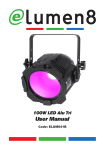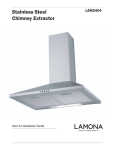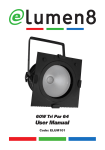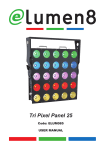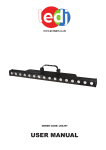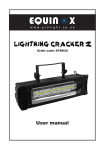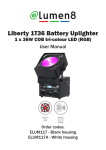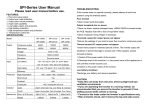Download 36 x 4W LED Alu CW/WW User Manual
Transcript
36 x 4W LED Alu CW/WW User Manual Code: ELUM044 1 2 Overview: You should find inside the Elumen8 carton the following items: 1, 36 x 4W LED Alu CW/WW Technical Specifications: 2, Instruction manual, 3, Power Cable DMX channels: 2/5/ or 6 selectable 36 x 4W CW/WW LEDs Dimming, master/slave and DMX modes 400Hz refresh rate 5-pin XLR in/out sockets 4 push button menu with LCD display Powercon in socket Beam angle: 30 degrees Power supply: 100-240V-50/60HZ Power consumption: 151W Weight: 4.9Kgs Operating modes: 1, Dimming 0-100% 2, DMX 3, Master/slave 4, Channel select 5, Dimming curves Overview: FUSE F2A~250V DMX IN POWER IN DMX OUT LCD DISPLAY MENU ENTER 3 UP DOWN Operation: 1, Dimming Mode To enter the dimming mode, press the “MODE” button to show “DIMMER” on the LCD display. Now press the “ENTER” button and use the “UP” and “DOWN” buttons to set the brightness of the Cool White LEDs from 00-99. Now press the “ENTER” button again and use the “UP” and “DOWN” buttons to set the brightness of the Warm White LEDs from 00-99. Now press the “ENTER” button a final time to add strobe and use the “UP” and “DOWN” buttons to change the flash speed from 00-99. NOTE: CW/WW: 99 = Dimming (00 = off, 99 = full on), F-99 = Flash (00 = off, 99 = fast) When you are happy with your choice, press the “ENTER” button to confirm it. 2, Slave Mode To enter slave mode, press the “MODE” button to show “SLAVE” on the LCD display. Now the unit will follow in sequence with the master unit. 3, Dimming Curve Mode The 36 x 4W CW/WW Alu includes two sets of dimming curves. The first is a Halogen emulation mode with a very smooth slow dimming and a small delay. The second is an LED response with faster dimming and no delay. To enter the dimming curve mode, press the “MODE” button to show “DIMMER CURVE” on the LCD display. Now press the “ENTER” button and use the “UP” and “DOWN” buttons to select between the 4 dimming curves from 01-08. 1-4 are for halogen response type : 01 = Linear, 5-8 are for LED response type : 05 = Linear, 02 = Square, 06 = Square, 03 = Inverse square, 07 = Inverse square, 04 = S-curve. 08 = S-curve. When you are happy with your setting, press the “ENTER” button to confirm it. LINEAR: the increase in light intensity appear to be linear as DMX value is increased. SQUARE: light intensity control is finer at low levels and coarser at high levels INVERSE SQUARE: light intensity control is coarser at low levels and finer at high levels S-CURVE: light intensity control is fine at low levels and high levels and coarser at medium levels. 4, Channel Mode To enter the channel mode, first press the mode button to show “CHANNEL” on the LCD display. Now press the “ENTER” button and use the “UP” and “DOWN” buttons to select 2/5 or 6 channel mode. 5, DMX Mode To enter the DMX mode, press the “MODE” button to show “DMX MODE” on the LCD display. Now press the “ENTER” button and use the “UP” and “DOWN” buttons to select the DMX address from 001-512. When you are happy with your setting, press the “ENTER” button to confirm it. Preset Colour Temperature Macro Mode To enter the Preset Colour Temperature Macro mode, press the “ENTER” button to show “PRESET” on the LCD display. Now press the “ENTER” button and use the “UP” and “DOWN” buttons to select from the 17 built-in preset colour temperature macros. Note: 1 = Warm, 17 = Cool 4 DMX Charts 2 channel mode: Channel Value Function CH1 0-255 Cool White Dimming 0-100% CH2 0-255 Warm White Dimming 0-100% 5 channel mode: Channel Value Function CH1 0-255 Cool White CH2 0-255 Warm White CH3 0-255 Master Dimmer 0-100% CH4 0-255 Strobe (slow to fast) CH5 0-255 17 Colour Temperature Macro Selector 6 channel mode: Channel Value Function CH1 0-255 Cool White CH2 0-255 Warm White CH3 0-255 Master Dimmer 0-100% CH4 0-255 Strobe (slow to fast) CH5 0-255 0-15 16-45 46-75 76-105 106-135 136-165 166-195 196-225 226-255 17 Colour Temperature Macro Selector Dimmer curve and response select on fixture Dimmer curve Linear response halogen Dimmer curve Square response halogen Dimmer curve Inverse Square response halogen Dimmer curve S response halogen Dimmer curve Linear response LED Dimmer curve Square response LED Dimmer curve Inverse Square response LED Dimmer curve S response LED CH6 5 DMX-512: • DMX (Digital Multiplex) is a universal protocol used as a form of communication between intelligent fixtures and controllers. A DMX controller sends DMX data instructions form the controller to the fixture. DMX data is sent as serial data that travels from fixture to fixture via the DATA “IN” and DATA “OUT” XLR terminals located on all DMX fixtures (most controllers only have a data “out” terminal). DMX Linking: • DMX is a language allowing all makes and models of different manufactures to be linked together and operate from a single controller, as long as all fixtures and the controller are DMX compliant. To ensure proper DMX data transmission, when using several DMX fixtures try to use the shortest cable path possible. The order in which fixtures are connected in a DMX line does not influence the DMX addressing. For example; a fixture assigned to a DMX address of 1 may be placed anywhere in a DMX line, at the beginning, at the end, or anywhere in the middle. When a fixture is assigned a DMX address of 1, the DMX controller knows to send DATA assigned to address 1 to that unit, no matter where it is located in the DMX chain. DATA Cable (DMX cable) requirements (for DMX operation): • The 36 x 4W LED Alu CW/WW can be controlled via DMX-512 protocol. The DMX address is set on the back of the unit. Your unit and your DMX controller require a standard 3-pin or 5-pin XLR connector for data input/ output (figure 1). Figure 1 Also remember that DMX cable must be daisy chained and cannot be split. 6 Notice: • Be sure to follow figures 2 & 3 when making your own cables. Do not connect the cable’s shield conductor to the ground lug or allow the shield conductor to come in contact with the XLR’s outer casing. Grounding the shield could cause a short circuit and erratic behaviour. Special Note: Line termination: • When longer runs of cable are used, you may need to use a terminator on the last unit to avoid erratic behaviour. Termination reduces signal transmission problems and interferance. it is always advisable to connect a DMX terminal, (resistance 120 Ohm 1/4 W) between pin 2 (DMX-) and pin 3 (DMX+) of the last fixture. Using a cable terminator (part number CABL90) will decrease the possibilities of erratic behaviour. 5-Pin XLR DMX Connectors: • Some manufactures use 5-pin XLR connectors for data transmission in place of 3-pin. 5-Pin XLR fixtures may be implemented in a 3-pin XLR DMX line. When inserting standard 5-pin XLR connectors in to a 3-pin line a cable adaptor must be used. The Chart below details the correct cable conversion. www.elumen8.co.uk








